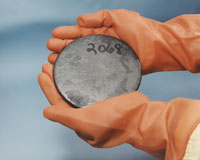Uranium is hard, malleable, ductile, and a poor electrical conductor. The metal has a very high density, around 70% denser than lead, yet less dense than gold.
Uranium has a melting point of 2,075 °F (1,135 °C) and a boiling point of 7,468 °F (4,131 °C).
The first atomic bomb used in World War II, dropped on Hiroshima, Japan, in 1945, contained a uranium core. Today nuclear bombs are usually made from other materials such as plutonium.
Over 33% of the world's uranium is mined in Kazakhstan. Other uranium mining countries include Canada, Australia, Namibia, Niger, and Russia.
Marie Curie's discovery of radium in uranium ore meant uranium mining increased so radium could be extracted to make glow-in-the-dark paints. It takes 3 tonnes of uranium to get 1 gram of radium, leaving massive amounts of uranium waste material which was sent for use in the glazing and tiling industry.
| | | 
| | More Metal Facts: | | | | | | | | | | | | Uranium Facts | |
|